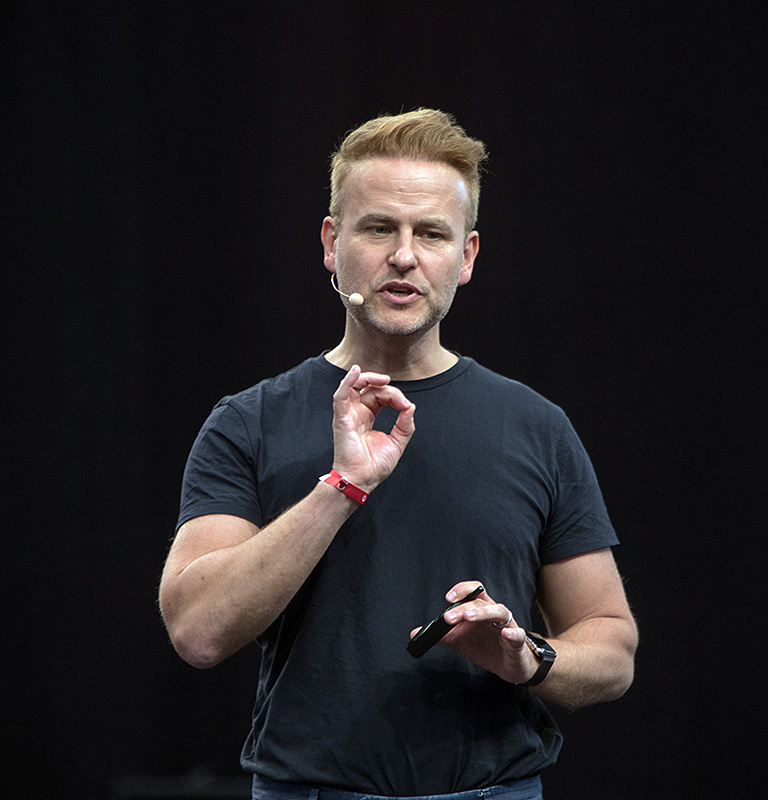
"Focus and get things moving!"
As a leading telco player, Vodafone is a pioneer for digital infrastructure. Together with undconsorten, Vodafone Germany has set up a digital accelerator for the business segment and introduced agile working approaches. In this interview, Martin Grabowski, Head of Products, Marketing and Partner Management Business, provides insights into Vodafone's agile transformation.
How did the Digital Accelerator come about?
Martin Grabowski: You can't simply ignore certain trends. That's why we kept thinking about what agile could mean for us in B2B. The majority of our work here is project business and not simply standardised. We wanted to use the Accelerator to better implement existing or upcoming new projects - through modern and agile working methods, new organisational setups, new role profiles, governance models and project process structures. On the one hand, this should lead to new motivation for our people and, of course, accelerate our time-to-market.

Vodafone Germany
The Accelerator was launched a year ago with several product teams. How would you rate the experience so far?
Martin Grabowski: It can already be described as a great success. I see this in three dimensions:
- We have made the new working approaches better known and more established within the company. Until a year ago, hardly anyone in B2B had heard of Scrum, Kanban, Design Thinking and all the other buzzwords in this environment.
- We have loosened up and dissolved established organisations, processes and situations. Years of project work had led to misunderstandings between the teams, which resulted in failures and misunderstandings due to unclear responsibilities. The agile approach led to a strong dynamic. Suddenly it was clear that there was someone who was clearly responsible for the project, the topic or the solution to the task from the team. This had the effect of pulling together again. Even seemingly simple things, such as sitting together as a team, contributed to this.
- Last but not least, you can of course see real progress in the projects when you attend the stand-ups and reviews. For example, we have achieved the first very good results with our 5G project with eGO and have therefore decided to take on new topics.
Can you think of a situation or story where you realised that the clocks were ticking differently?
Martin Grabowski: There were examples of how we were able to bring projects to a successful conclusion that stagnated because teams were frustrated, relationships were muddled, budgets and roles were unclear. In addition, there were changes in the management team, which meant that we no longer knew exactly who was responsible for what at the end of the day.
We mobilised something there with the transition to agile approaches. It's easy to see how agile has helped to minimise the risk of losing sight of the big picture in very large cross-functional projects. The division into sub-projects with individual milestones, short-term successes and sprints has led to a special dynamic. In the old project, the team thought under all the pressure and frustration: "We still have 12 to 18 months and then we have to deliver the whole thing. We'll never manage that!" With the new approach, on the one hand there is the perspective of "We want to have achieved this in about a year", but on the other hand there are also the many small successes in between. An MVP is created, it is tested, there are new findings that lead to new work packages. Small success stories are reported, teams see progress.
"To be fair, it also takes quite a while to set up the projects from scratch like this."
It was a lot of work for you as supporters, but also for the project teams and established resources. During onboarding, we had to do a lot of liaising, provide resources, talk to people and discuss topics that hadn't come up before.
What challenges did you face?
Martin Grabowski: The biggest challenge was definitely coordinating the whole thing with corporate processes, guidelines and approval processes. There are still construction sites: The squads are sometimes faster than the organisation. How do you define freedoms and budgets? Who decides and who is informed? There are challenges when you install an agile island in a traditional organisational structure. But we have managed to introduce agile, secure broad support and have several successful projects running in parallel as a result.
"You also need new people with the right skills, you don't get them overnight, they are rare on the market."
And you can see that we have a limited number of specialists with the right skills required for individual features. So we need to broaden the knowledge base so that the teams are not slowed down or colleagues have to dance on too many construction sites.
What do you think is a success factor for agile, especially from an employee perspective?
Martin Grabowski: I believe that, as in sport, close collaboration and team building create a dynamic. You have successes, feel a sense of belonging, identify with them, have clear but not overly ambitious goals. You are simply motivated. If you get it right, you feel valued, have a sense of achievement and that motivates you. It's not so fictitious, along the lines of: "I don't care if I meet the sprint target, I'll just do it next week". The team members take responsibility. You stand in front of the board in the morning and see that progress is being made everywhere. But you didn't fulfil your tasks and now we're stuck as a team. That sounds trivial, but dynamics help a company to stay clear and focussed.
How do you experience the change in leadership?
Martin Grabowski: The main issue is to create an awareness of the fact that even in a company, it is speed, results, flexibility and time-to-market that ultimately win - from PowerPoint to execution. The project is not the goal. It's not about being happy about an approval and managing a waterfall project for three years with a budget of X million. Of course, leadership is also about results, speed and agility, as the environment around you is also changing.
"Of course, our young and talented employees in particular have totally embraced agile and are having a blast. But the old hands in management have also been mobilised and shaken up."
The senior leadership boards, for example: new topics and new people came to present. They talk about the last sprint and the problems they encountered - the management then had to start dealing with them in order to remove the blockages.
Agile is good, but not everywhere. Where would you say it makes the most sense for you?
Martin Grabowski: For us, Agile has proved very successful when cross-functional teams have to implement a project, product or idea within a manageable period of time - often with difficult governance. The model has the charm of having a dedicated team that you can approach, look at and focus on - focus is always very difficult in such a large organisation. Of course there is always a team that meets somewhere with regular appointments. Of course there are X people working on Powerpoints, but everyone also has 15 other balls to hold up, their day-to-day business and other stakeholders, in other words: conflicting goals. It is therefore important to define a clear task in advance - but no more! In our context, you can't turn the squad into a permanent institution that replaces a line.
What advice would you give other companies?
Martin Grabowski: The most important thing is to consider at the very beginning where agile working makes sense and where it does not. And then work out your specific solution. We also looked at best practice in our first sessions, but you still have to use common sense and say: let's take a close look at where our problems and our business are.
Another point is: you have to take people with you. You have to be careful that you don't approach it like: "There's a new hip group ... and then there are the others". I always involved all managers, even though I knew that squads or agile approaches would not be introduced everywhere. Even with employees, we didn't say that we would only involve those who work in these groups, but rather everyone. The effect was that fears, prejudices and barriers were broken down.




